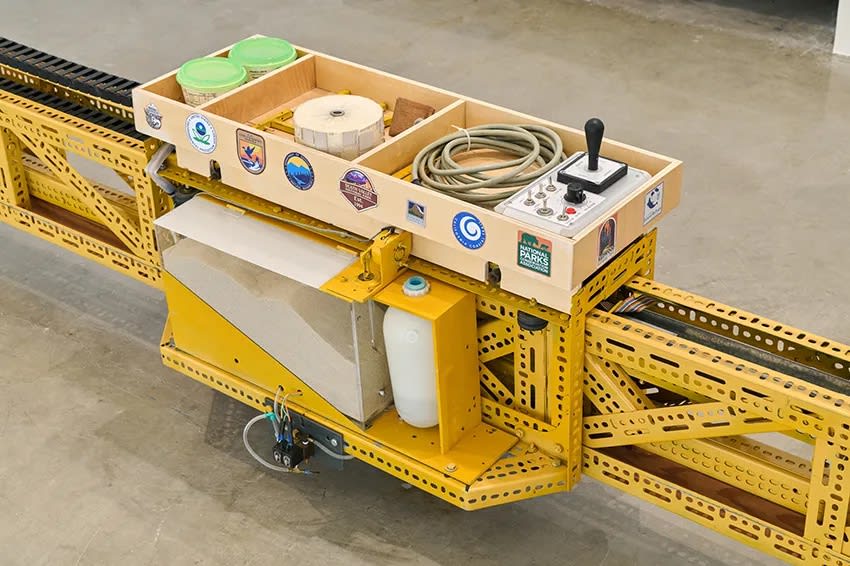Contemporary Art Review Los Angeles (Carla) | Carl Cheng at REDCAT
Fabruary 1, 2023 | Holyoak, Vanessa.
The post-minimalist artist/inventor Carl Cheng has, over his nearly six-decade career, regularly produced the very tools used to fabricate his innovative installations and sculptures. Despite variations in size and complexity, these tools all attempt to automate the artistic process by way of devices that can themselves be seen as artworks. Cheng’s Material Behavior at REDCAT offers a focused, compelling glimpse into the artist’s prolonged meditation on the tool as an extension of artistic practice.
The show presents a single, sprawling work called Human Landscape (all works 2022), a rectangular expanse of sand imprinted with irregular markings that together resemble an organized system. The marks evoke agrarian forms, like crop circles or neatly plowed fields, as well as the forbidding architecture of a rural military base. The overall effect of this collapse of scales is that of witnessing a desert farming landscape from a plane, both dizzying and humbling.
The sand markings are amorphous yet controlled: a series of raked spirals give way to the kind of geometrically perfect lines and circles that only a machine could have produced; repetitive indentations read like hieroglyphs or the sockets and pins of a computer hard drive. A row of powerful theater footlights illuminates this landscape laterally, casting a white glow that creates shadows while bathing the idiosyncratic patterns formed by alternating hills and impressions in a cold, clinical light. The lighting recalls an array of illuminating apparatuses: surveillance technology, a football field lit at night, or an operating room. A bed of sand becomes a site of illusion rife with potential signification, inviting viewers to project visions of natural and human-made phenomena.
The particular tool that Cheng used to create this work—Art Tool: Rake 1022—can be found toward the back of the gallery. A similar tool appeared in Cheng’s Natural Museum of Modern Art (1979), a public art intervention at the Santa Monica Pier. With each iteration, Cheng adds components that broaden the tool’s gestural, and in turn, sculptural, vocabulary, and a unique, ephemeral sculpture is produced. The current version can drop water, blow air, and draw impressions. A horizontal, bright yellow structure on wheels, the rake resembles a nondescript piece of construction equipment aside from a lidless wooden box decorated with stickers from various national parks that sits atop the rake and holds its joystick.
In the context of increasingly sophisticated artificial intelligence—a more topical automating tool—and the resulting rise of AI art (and the economic, ethical, and aesthetic questions it provokes), it is tempting to read Cheng’s long-term exploration of automating processes as a kind of proto-AI experimentation. Yet Cheng’s automatons read more as parables of human technological intervention into the environment. Their stakes are much more analog: “hacks” of the readymade art object, they offer a utility that is only “useful” aesthetically, which is to say, not at all. The only function of this machine is to draw ephemeral lines in the sand that might invoke and invite reflections on the paraphernalia of contemporary life, from the military-industrial complex to the calming textures of a zen garden.
Uninterested in technology as error-free mimesis of humans, Cheng’s tools don’t take themselves too seriously—and even make a mockery of blind attempts at technological advance in their absurdist choreography. They intuit the automation already inherent in human, and thus in artistic, choices, informed, as they are, by one’s natural and cultural environment. As such, Human Landscape is a collaboration between the artist and his machine that underscores, again, the obsolescence of such distinctions.
Carl Cheng: Material Behavior runs from October 22, 2022 - March 12, 2023 at REDCAT (631 W. 2nd St., Los Angeles, CA 90012).





